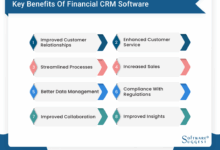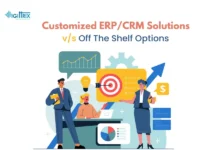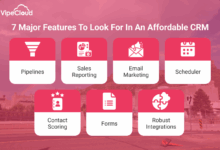CRM For Sales And Marketing Automation: Streamlining Customer Relationship Management
Kicking off with CRM for Sales and Marketing Automation, this technology-driven approach enhances customer relationships while optimizing sales and marketing processes. Dive into the world of CRM to unlock its potential for your business growth.
Introduction to CRM for Sales and Marketing Automation
CRM, or Customer Relationship Management, is a technology that helps businesses manage interactions with current and potential customers. It involves using data analysis about customer history to improve business relationships, specifically focusing on customer retention and driving sales growth.
Benefits of CRM for Sales and Marketing Automation
- Improved Efficiency: CRM streamlines processes, automates repetitive tasks, and provides a centralized database for easy access to customer information.
- Enhanced Customer Relationships: By tracking customer interactions and preferences, CRM enables personalized communication and targeted marketing strategies.
- Increased Sales: CRM helps sales teams prioritize leads, identify upsell opportunities, and track the sales pipeline for better forecasting.
- Data-driven Insights: CRM provides valuable analytics and reporting tools to optimize marketing campaigns, measure ROI, and make informed business decisions.
Role of CRM in Improving Customer Relationships
CRM plays a crucial role in enhancing customer relationships by:
- Centralizing Customer Data: All customer information, interactions, and transactions are stored in one place, enabling a comprehensive view of each customer.
- Personalizing Interactions: CRM allows businesses to tailor communication based on customer preferences, behaviors, and purchase history, leading to more meaningful engagements.
- Providing Timely Follow-ups: With automated reminders and notifications, CRM ensures that no customer inquiry or follow-up falls through the cracks, enhancing customer satisfaction.
Key Features of CRM Software
CRM software for sales and marketing automation comes with a variety of essential features that help businesses streamline their processes, improve efficiency, and boost sales. These features include:
Data Management and Organization
– CRM software allows businesses to store and manage customer data in a centralized database, making it easy to access and update information.
– Organize customer information such as contact details, purchase history, interactions, and preferences for personalized communication and targeted marketing campaigns.
Lead Management
– Automate lead capturing, scoring, and nurturing processes to identify and prioritize high-quality leads.
– Track lead interactions, follow-ups, and conversions to optimize sales strategies and increase conversion rates.
Workflow Automation
– Automate repetitive tasks such as sending emails, scheduling appointments, and updating records to save time and improve productivity.
– Set up automated workflows for sales and marketing processes to ensure timely follow-ups and consistent communication with leads and customers.
Reporting and Analytics
– Generate detailed reports and analytics on sales performance, customer engagement, and marketing campaigns to identify trends, track progress, and make data-driven decisions.
– Monitor key performance indicators (KPIs) to evaluate the effectiveness of sales and marketing strategies and optimize business operations.
Integration Capabilities
– Integrate CRM software with other business tools and platforms such as email marketing software, e-commerce platforms, and social media channels for seamless data sharing and enhanced functionalities.
– Ensure data consistency and eliminate silos by integrating CRM with other systems to provide a unified view of customer interactions and transactions.
Mobile Accessibility
– Access CRM data and tools on-the-go through mobile applications to stay connected with leads and customers, collaborate with team members, and manage tasks from anywhere.
– Enable remote work and flexibility for sales and marketing teams to access real-time information and updates while in the field or working remotely.
Customization and Scalability
– Customize CRM software according to business needs and requirements by adding or removing features, fields, and modules to align with specific processes and workflows.
– Scale CRM solutions as the business grows and evolves, accommodating an increasing number of users, customers, and data without compromising performance and efficiency.
Implementing CRM Systems
Implementing a CRM system is a crucial step for businesses looking to streamline their sales and marketing processes. It involves a series of steps and considerations to ensure a successful integration of the software into existing operations.
Steps to Successfully Implement a CRM System
- Define clear objectives and goals for implementing the CRM system.
- Select the right CRM software that aligns with your business needs and budget.
- Involve key stakeholders from sales, marketing, and IT departments in the decision-making process.
- Create a detailed implementation plan with timelines and milestones.
- Provide adequate training to employees on how to use the CRM system effectively.
Common Challenges Faced During CRM Implementation
- Resistance to change from employees who are used to traditional methods.
- Data quality issues leading to inaccurate insights and reporting.
- Lack of proper communication and collaboration between departments.
- Integration challenges with existing systems and processes.
Tips for Integrating CRM with Existing Sales and Marketing Strategies
- Map out current sales and marketing processes to identify integration points.
- Customize the CRM system to align with existing workflows and strategies.
- Encourage cross-departmental collaboration to ensure a smooth integration.
Importance of Training Employees on Using the CRM System Effectively
Effective training is essential to ensure that employees can leverage the full capabilities of the CRM system. It helps in improving data accuracy, enhancing productivity, and driving better customer relationships.
Best Practices for Data Migration When Transitioning to a New CRM Platform
- Cleanse and organize data before migration to avoid duplicates and inaccuracies.
- Ensure data mapping between the old and new CRM systems is accurate.
- Conduct regular data audits post-migration to identify any issues and make necessary corrections.
Ways to Measure the Success and ROI of a CRM Implementation
- Track increases in sales revenue and customer retention rates post-implementation.
- Monitor improvements in lead conversion rates and sales team productivity.
- Analyze customer satisfaction scores and feedback to gauge the impact of the CRM system.
Examples of Key Performance Indicators (KPIs) that Can be Tracked Post-CRM Implementation
- Sales revenue growth
- Customer acquisition cost
- Marketing campaign ROI
- Customer lifetime value
Data Management in CRM
Effective data management is crucial in Customer Relationship Management (CRM) systems as it allows businesses to gather, organize, and analyze customer information to make informed decisions. Here, we will explore the importance of data management in CRM, strategies for collecting and organizing customer data effectively, and how CRM systems assist in data analysis for sales and marketing decisions.
Importance of Data Management in CRM
Proper data management in CRM ensures that businesses have accurate and up-to-date information about their customers. This enables them to personalize interactions, identify trends, and forecast future needs effectively.
Strategies for Collecting and Organizing Customer Data Effectively
- Implementing data capture tools on various touchpoints such as websites, social media, and sales platforms to gather relevant customer information.
- Segmenting customer data based on demographics, purchase history, and behavior to tailor marketing strategies accordingly.
- Regularly updating and cleansing the database to remove duplicate or outdated information and ensure data accuracy.
How CRM Systems Help in Data Analysis for Sales and Marketing Decisions
- CRM systems provide comprehensive reporting and analytics tools to track customer interactions, sales performance, and marketing campaigns.
- By analyzing data stored in CRM systems, businesses can identify opportunities for upselling, cross-selling, and customer retention.
- Integration with business intelligence tools allows for in-depth analysis of customer data to make data-driven decisions that drive business growth.
Customization and Personalization in CRM
Customization plays a crucial role in CRM for creating personalized customer interactions. Tailoring CRM systems to meet specific business needs can greatly enhance the sales and marketing process by providing a more targeted approach to customer engagement.
Importance of Data Segmentation and Targeted Communication
- Data segmentation allows businesses to categorize customers based on specific criteria such as demographics, purchase history, and behavior patterns. This enables targeted communication that resonates with each customer segment.
- Targeted communication in CRM ensures that messages are relevant to each customer, leading to higher engagement rates and increased conversions.
Setting up Personalized Email Marketing Campaigns
- Define your target audience and segment your email list based on demographics, preferences, and past interactions.
- Create personalized email content that speaks directly to the needs and interests of each customer segment.
- Use dynamic content and automation features within your CRM platform to customize emails based on individual customer data and behavior.
Integrating Social Media Data into CRM
- Integrating social media data into CRM systems allows businesses to gain insights into customer preferences, interests, and online behavior.
- By analyzing social media data, businesses can personalize their interactions with customers across different channels, creating a more seamless and personalized customer experience.
Generic Marketing Strategies vs. Personalized Marketing Strategies
- Generic marketing strategies involve mass communication to a broad audience, while personalized marketing strategies focus on individualized messaging tailored to specific customer segments.
- Personalized marketing strategies in CRM have been shown to generate higher conversion rates, increased customer loyalty, and improved customer satisfaction compared to generic approaches.
Reporting and Analytics in CRM
Reporting and analytics play a crucial role in CRM for sales and marketing teams as they provide valuable insights to track performance, measure success, and make informed decisions.
Key Metrics to Track Using CRM Software
- Sales Revenue: Monitor the revenue generated from sales activities to assess the effectiveness of sales strategies.
- Customer Acquisition Cost (CAC): Calculate the cost incurred to acquire a new customer, helping in budget planning and resource allocation.
- Customer Retention Rate: Track the percentage of customers retained over a specific period to evaluate customer satisfaction and loyalty.
- Lead Conversion Rate: Measure the rate at which leads are converted into customers, indicating the efficiency of the sales process.
Data Insights Driving Strategic Decision-Making
By leveraging data insights from CRM systems, organizations can make strategic decisions based on real-time information and trends. These insights help in identifying opportunities, understanding customer behavior, and forecasting future sales trends. With access to accurate data and analytics, businesses can optimize their sales and marketing strategies, improve customer relationships, and ultimately drive growth and profitability.
Integrating CRM with Marketing Automation
Integrating CRM with marketing automation tools can significantly enhance the overall efficiency and effectiveness of sales and marketing strategies. By seamlessly connecting these two systems, businesses can streamline lead generation, improve customer engagement, and increase conversion rates.
Benefits of Integrating CRM with Marketing Automation
- Improved lead management and tracking
- Enhanced customer segmentation and targeting
- Automated personalized communication
- Increased collaboration between sales and marketing teams
Examples of Seamless Integration Enhancing Lead Generation and Nurturing
- Automated lead scoring and nurturing based on CRM data
- Triggered email campaigns based on customer interactions
- Personalized content recommendations for leads
Strategies for Aligning Sales and Marketing Efforts through CRM Integration
- Establishing shared goals and KPIs
- Implementing lead handoff processes between teams
- Leveraging CRM data to optimize marketing campaigns
Key Differences Between CRM and Marketing Automation Systems
- CRM focuses on managing customer relationships and sales processes
- Marketing automation is geared towards automating marketing activities
- CRM stores customer data and interactions, while marketing automation drives lead nurturing and engagement
Achieving Personalized Customer Interactions through CRM and Marketing Automation Integration
- Utilizing customer data for targeted messaging and offers
- Implementing dynamic content based on customer preferences
- Creating personalized customer journeys across marketing and sales touchpoints
Role of Data Analytics in Optimizing CRM and Marketing Automation Integration
- Analyzing customer behavior and engagement metrics for insights
- Tracking the performance of marketing campaigns and sales activities
- Leveraging data-driven decisions to enhance lead generation and conversion strategies
Customer Journey Mapping with CRM
Customer journey mapping with CRM involves utilizing the data and insights gathered within the CRM system to visualize and understand the various touchpoints and interactions a customer has with a business throughout their journey. This process helps businesses gain a deeper understanding of their customers’ needs, behaviors, and preferences.
Impact of Customer Journey Mapping on Sales and Marketing Strategies
Customer journey mapping has a significant impact on sales and marketing strategies by enabling businesses to tailor their approach based on the specific needs and preferences of customers at different stages of the journey. It allows for more personalized and targeted communication, leading to improved customer engagement and higher conversion rates.
- Identify key touchpoints: By mapping the customer journey, businesses can identify the key touchpoints where customers interact with the brand, allowing them to optimize these interactions for a seamless experience.
- Enhance customer experience: Understanding the customer journey helps businesses identify pain points and areas for improvement, leading to a more streamlined and satisfying customer experience.
- Improve marketing effectiveness: By mapping the customer journey, businesses can ensure that their marketing efforts are targeted and relevant, increasing the effectiveness of their campaigns.
Tips for Leveraging CRM Data to Optimize the Customer Experience
Leveraging CRM data to optimize the customer experience involves using the insights and information gathered within the CRM system to tailor interactions and communication with customers. Some tips include:
- Segment customers based on behavior and preferences
- Personalize communication and offers
- Use automation to deliver timely and relevant messages
Step-by-Step Guide on Creating a Customer Journey Map using CRM Data
Creating a customer journey map using CRM data involves several steps:
- Collect and analyze customer data from the CRM system
- Identify key touchpoints and interactions
- Create a visual representation of the customer journey
- Analyze the map to identify areas for improvement
Benefits of Using CRM Software versus Traditional Methods for Customer Journey Mapping
Using CRM software for customer journey mapping offers several benefits over traditional methods, including:
- Centralized data storage and easy access to customer information
- Real-time insights and analytics for more informed decision-making
- Automation capabilities for personalized and timely communication
Real-Life Case Studies on Improved Customer Journey Mapping Processes
Several real-life case studies demonstrate how CRM systems have significantly improved customer journey mapping processes, leading to enhanced customer satisfaction and increased sales. For example, Company X implemented CRM software to track customer interactions and tailor their marketing campaigns, resulting in a 20% increase in customer retention.
Key Metrics to Track within CRM for Effective Customer Journey Mapping
Some key metrics to track within CRM for effective customer journey mapping include:
Customer acquisition cost, Customer lifetime value, Conversion rates, Customer satisfaction scores
Sample Customer Journey Map Based on Hypothetical CRM Data
Here is a sample customer journey map based on hypothetical CRM data:
| Stage | Touchpoints | Actions |
|---|---|---|
| Awareness | Website visit | Sign up for newsletter |
| Evaluation | Product demo | Request a quote |
| Purchase | Online purchase | Receive order confirmation |
Lead Management in CRM
CRM plays a crucial role in managing leads and converting them into customers. By utilizing CRM systems, businesses can efficiently track and manage leads throughout the sales process, ultimately improving conversion rates.
Lead Scoring Techniques and Automation
Lead scoring is a method used to rank leads based on their likelihood to convert into customers. CRM systems can automate this process by assigning scores to leads based on various criteria such as demographic information, online behavior, and engagement with marketing materials. By prioritizing high-scoring leads, sales teams can focus their efforts on leads with the highest potential for conversion.
- Utilize demographic data: CRM systems can analyze lead data such as job title, company size, and industry to determine the likelihood of conversion.
- Track online behavior: By monitoring lead interactions with emails, website visits, and social media engagement, CRM systems can identify interested leads.
- Engagement with marketing materials: Tracking lead interactions with marketing campaigns allows CRM systems to assign scores based on engagement levels.
Automation in lead scoring helps streamline the sales process and ensures that sales teams are focusing their efforts on leads with the highest potential for conversion.
Best Practices for Nurturing Leads through CRM
Nurturing leads is essential for guiding them through the sales funnel and ultimately converting them into customers. By leveraging CRM tools and strategies, businesses can effectively nurture leads and improve sales outcomes.
- Personalized communication: Use CRM data to personalize communication with leads based on their preferences and interests.
- Timely follow-ups: Set up automated follow-up sequences to ensure leads are engaged at the right time.
- Lead segmentation: Segment leads based on criteria such as industry, behavior, and interests to tailor marketing messages accordingly.
- Continuous monitoring: Regularly monitor lead interactions and adjust strategies based on their responses to improve engagement.
Mobile CRM Solutions
Mobile CRM solutions play a crucial role in today’s dynamic business environment, allowing sales teams to access customer information on the go and stay productive while out in the field. Let’s explore the key features, customization options, integration possibilities, security measures, and a real-life case study of successful mobile CRM implementation.
Key Features and Functionalities of Mobile CRM Solutions
- Real-time access to customer data
- Location-based services for field sales representatives
- Offline access capabilities for areas with poor connectivity
- Seamless synchronization with desktop CRM systems
- Mobile-friendly interface for ease of use
Comparison of Different Mobile CRM Platforms
| CRM Platform | Key Features | Integration Options |
|---|---|---|
| Platform A | Feature 1, Feature 2, Feature 3 | Integration with Tool X, Tool Y |
| Platform B | Feature 1, Feature 4, Feature 5 | Integration with Tool Z, Tool W |
Setting Up and Customizing a Mobile CRM System
- Choose the right mobile CRM platform based on team requirements
- Configure user roles and permissions for data access control
- Customize fields, forms, and workflows to align with sales processes
- Train the sales team on how to use the mobile CRM effectively
Integrating Mobile CRM with Existing Sales and Marketing Tools
- Assess compatibility between mobile CRM and current tools
- Establish data synchronization protocols to ensure data consistency
- Map out the integration process step by step for a smooth transition
- Test the integration thoroughly before full implementation
Security Measures and Best Practices for Mobile CRM Solutions
- Implement secure login procedures and data encryption
- Regularly update mobile CRM apps to patch security vulnerabilities
- Enforce strong password policies and multi-factor authentication
- Backup data regularly to prevent loss in case of device theft or damage
Case Study: Successful Implementation of Mobile CRM
XYZ Corporation, a leading tech company, implemented a mobile CRM solution that increased sales team productivity by 30% within the first quarter. By customizing the CRM platform to match their unique sales processes and integrating it with existing tools, XYZ Corporation streamlined their operations and improved customer interactions significantly.
CRM Security and Compliance
Data security and compliance are crucial aspects of CRM systems to protect sensitive information and ensure adherence to regulations. Implementing strategies for data protection and privacy within CRM is essential to maintain trust with customers and meet legal requirements.
Strategies for Ensuring Data Protection
- Implement role-based access control to restrict data access based on user roles.
- Regularly update and patch CRM software to address security vulnerabilities.
- Train employees on data security best practices and the importance of safeguarding customer information.
Industry Regulations and Standards
- GDPR (General Data Protection Regulation) for protecting personal data of individuals within the EU.
- HIPAA (Health Insurance Portability and Accountability Act) for safeguarding healthcare data in the U.S.
Role of Encryption in Data Security
Encryption helps in securing data by converting it into a coded format that can only be accessed with the right decryption key.
Common Security Threats and Mitigation
- Phishing attacks targeting CRM users can be mitigated through employee training and email verification processes.
- Malware infections can be prevented by using anti-malware software and regularly scanning CRM systems.
Impact of Non-Compliance on CRM Operations
Non-compliance with data protection regulations can lead to fines, legal penalties, and reputational damage for businesses using CRM systems.
Benefits of Security Audits
- Identifying vulnerabilities and weaknesses in the CRM system.
- Ensuring compliance with data protection laws and regulations.
Training and User Adoption of CRM
Training and user adoption are crucial aspects of successful CRM implementation. Without proper training programs, users may struggle to fully utilize the CRM software, leading to underwhelming results. Here are some tips and strategies to encourage user adoption and engagement with CRM software.
Significance of Training Programs
Implementing comprehensive training programs is essential for successful CRM adoption. It ensures that users understand the functionalities of the CRM software and can leverage its features to enhance their productivity and efficiency.
- Provide hands-on training sessions to allow users to practice using the CRM software in a simulated environment.
- Offer training materials such as user guides, video tutorials, and FAQs to support different learning preferences.
- Regularly assess user knowledge and skills through quizzes or assessments to track progress and identify areas for improvement.
Encouraging User Adoption
To encourage user adoption, it is essential to create a positive attitude towards CRM software within the organization. Here are some strategies to boost engagement:
Encourage leadership buy-in and support to set a precedent for the importance of CRM software within the organization.
- Communicate the benefits of CRM software to users and highlight how it can streamline processes and improve customer relationships.
- Create incentives or rewards for users who actively engage with the CRM system and demonstrate proficiency in using its features.
- Solicit feedback from users to address any concerns or challenges they may face with the CRM software and provide timely support and guidance.
Ongoing Training and Support
Continuous training and support are essential to maximize the benefits of CRM software. By offering ongoing training sessions and support resources, organizations can ensure that users remain proficient in using the CRM system and adapt to any updates or changes effectively.
- Organize regular training sessions to introduce new features or functionalities of the CRM software and reinforce existing knowledge.
- Provide user support channels such as a help desk, online chat support, or dedicated CRM specialists to address user queries and issues promptly.
- Offer refresher courses or advanced training modules for users to deepen their understanding and skills in using the CRM software.
Personalized Training Sessions
Tailoring training sessions to different user roles within the organization is essential to ensure that users receive relevant and targeted information that aligns with their responsibilities and tasks. Personalized training sessions can enhance user engagement and retention of CRM knowledge.
- Identify the specific needs and requirements of different user roles within the organization to customize training content accordingly.
- Offer role-specific training modules that focus on the functionalities and features most relevant to each user group.
- Provide hands-on exercises and case studies that reflect real-world scenarios faced by users in their respective roles.
Interactive Training Materials
Creating interactive training materials can enhance user engagement and make the learning process more dynamic and effective. Interactive elements such as quizzes, simulations, and multimedia content can help users retain information and apply their knowledge in practical scenarios.
- Develop interactive e-learning modules that allow users to interact with the CRM software interface and practice using its features in a controlled environment.
- Incorporate gamification elements such as leaderboards, badges, and rewards to incentivize user participation and progress in training activities.
- Utilize virtual reality or augmented reality technology to simulate realistic CRM usage scenarios and provide immersive training experiences for users.
User Feedback and Mentorship Program
User feedback plays a crucial role in refining training programs and addressing user needs effectively. By collecting feedback from users, organizations can continuously improve training materials and support resources to enhance CRM adoption. Additionally, setting up a mentorship program can support new users in navigating the CRM system effectively and accelerating their learning curve.
- Conduct surveys or feedback sessions to gather input from users on their training experience, challenges faced, and suggestions for improvement.
- Use feedback data to identify common issues or areas of improvement in training programs and make necessary adjustments to enhance user satisfaction and engagement.
- Establish a mentorship program where experienced users or CRM champions can guide new users in using the CRM software effectively, providing tips, best practices, and support throughout their onboarding process.
CRM Integration with Other Business Systems
Integrating CRM with other business systems such as ERP and BI can offer numerous benefits to organizations, including improved data visibility and streamlined processes.
Advantages of CRM Integration
- Enhanced cross-departmental collaboration by providing a centralized platform for sharing customer information.
- Increased productivity through automation of tasks and workflows across different systems.
- Better decision-making with access to comprehensive data from various departments.
Challenges and Considerations
- Compatibility issues between CRM and existing systems.
- Data mapping complexity to ensure seamless data flow between systems.
- Training employees on new integrated processes.
Key Steps in CRM Integration Project
- Define integration goals and objectives.
- Conduct a thorough system analysis to identify integration points.
- Select appropriate integration tools and technologies.
- Develop a detailed integration plan and timeline.
- Test the integration thoroughly before full deployment.
Real-time Integration vs Batch Processing
- Real-time integration offers immediate data updates but may require more resources.
- Batch processing is more efficient for large data volumes but can result in delayed information access.
Data Synchronization in CRM Integration
- Ensures consistency and accuracy of information across integrated systems.
- Automates data updates to prevent discrepancies.
Case Study: CRM Integration with Marketing Automation
A leading e-commerce company integrated their CRM system with marketing automation tools to personalize customer interactions and increase sales by 20% within the first quarter.
Security Measures for CRM Integration
- Encrypt sensitive customer data during transfer and storage.
- Implement user access controls to restrict unauthorized data access.
- Regularly monitor and audit data access to detect potential security breaches.
Future Trends in CRM for Sales and Marketing Automation
The landscape of Customer Relationship Management (CRM) for Sales and Marketing Automation is constantly evolving, driven by technological advancements and changing consumer behaviors. Let’s delve into the upcoming trends that are set to shape the future of CRM systems and their impact on sales and marketing strategies.
Role of AI and Machine Learning in CRM
AI and machine learning are poised to play a pivotal role in the future of CRM systems. These technologies enable businesses to analyze vast amounts of data, identify patterns, and make data-driven decisions in real-time. By leveraging AI and machine learning algorithms, CRM systems can provide personalized recommendations, automate routine tasks, and optimize sales and marketing efforts for enhanced customer engagement and improved ROI.
- AI-powered Predictive Analytics: AI algorithms can analyze historical customer data to predict future trends, customer behavior, and potential leads, enabling businesses to proactively engage with customers and tailor their marketing strategies accordingly.
- Chatbots and Virtual Assistants: AI-driven chatbots and virtual assistants can help businesses streamline customer interactions, provide instant support, and gather valuable customer insights round the clock, enhancing customer satisfaction and loyalty.
- Dynamic Pricing Strategies: AI can analyze market trends, competitor pricing, and customer preferences to recommend dynamic pricing strategies that maximize revenue and customer acquisition.
Emerging Technologies Revolutionizing CRM
The emergence of new technologies is set to revolutionize CRM practices, offering innovative solutions to meet the evolving needs of businesses and customers alike.
- Blockchain for Secure Data Management: Blockchain technology can enhance data security, transparency, and integrity in CRM systems, ensuring that customer data remains protected and tamper-proof.
- Internet of Things (IoT) Integration: IoT devices can provide real-time customer data and insights, enabling businesses to deliver personalized experiences, automate processes, and improve customer engagement across various touchpoints.
- Voice-enabled CRM Systems: Voice recognition technology allows users to interact with CRM systems using voice commands, streamlining tasks, and enhancing user experience for increased productivity and efficiency.
Case Studies and Success Stories
In this section, we will explore real-world examples of companies that have successfully utilized CRM for sales and marketing automation and analyze the strategies and outcomes of implementing CRM in different industries. We will also discuss key takeaways and lessons learned from CRM success stories.
Company A: Retail Industry
- Company A, a retail giant, implemented a CRM system to streamline their sales processes and improve customer engagement.
- By integrating CRM with their marketing automation platform, Company A was able to personalize marketing campaigns and target specific customer segments effectively.
- As a result, Company A saw a significant increase in sales revenue and customer retention rates.
Company B: Technology Sector
- Company B, a tech company, adopted CRM to manage their leads and track customer interactions more efficiently.
- Through the use of reporting and analytics features in CRM, Company B gained valuable insights into their sales pipeline and customer behavior.
- This data-driven approach helped Company B to optimize their sales strategies and improve overall performance.
Key Takeaways
- Personalization and customization are essential for successful CRM implementation.
- Data management and analysis play a crucial role in driving business growth and improving customer relationships.
- Training and user adoption are key factors in maximizing the benefits of CRM systems.
Final Conclusion
In conclusion, CRM for Sales and Marketing Automation offers a dynamic solution to boost customer engagement and drive sales success. Embrace the power of CRM to revolutionize your business strategies and stay ahead of the competition.





